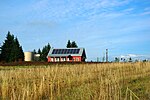Scholls, Oregon
1871 establishments in OregonPopulated places established in 1871Unincorporated communities in OregonUnincorporated communities in Washington County, OregonUse mdy dates from July 2023

Scholls, Oregon is an unincorporated community in Washington County, Oregon, United States. It is located along the southern shore of the Tualatin River, near the intersection of Oregon Routes 210 and 219. Scholls is located approximately seven miles north of Newberg, seven miles west of Tigard and eight miles south of Hillsboro. The area around Scholls is primarily agricultural.
Excerpt from the Wikipedia article Scholls, Oregon (License: CC BY-SA 3.0, Authors, Images).Scholls, Oregon
Southwest Scholls Ferry Road, Hillsboro
Geographical coordinates (GPS) Address Nearby Places Show on map
Geographical coordinates (GPS)
| Latitude | Longitude |
|---|---|
| N 45.408055555556 ° | E -122.92222222222 ° |
Address
Southwest Scholls Ferry Road 23905
97123 Hillsboro
Oregon, United States
Open on Google Maps









